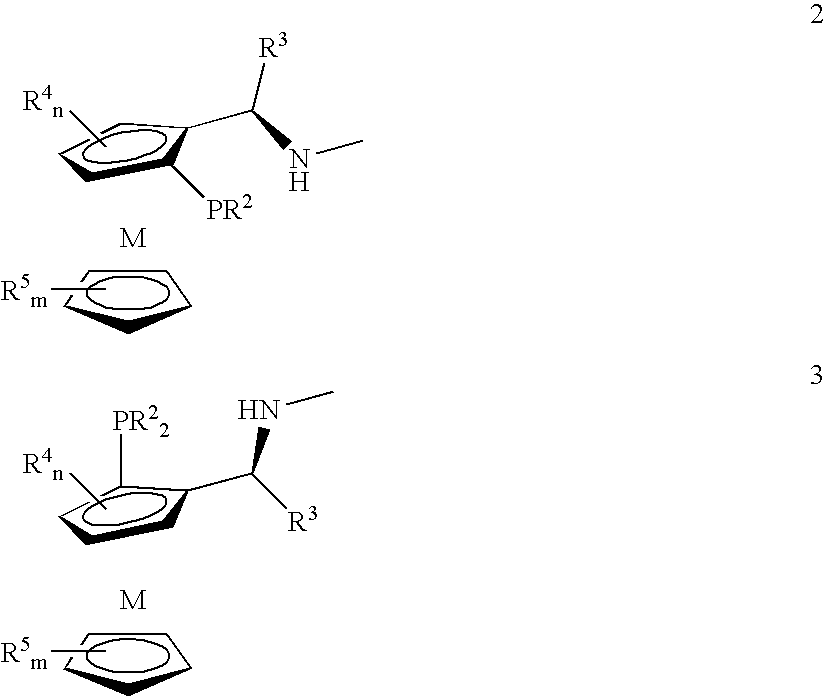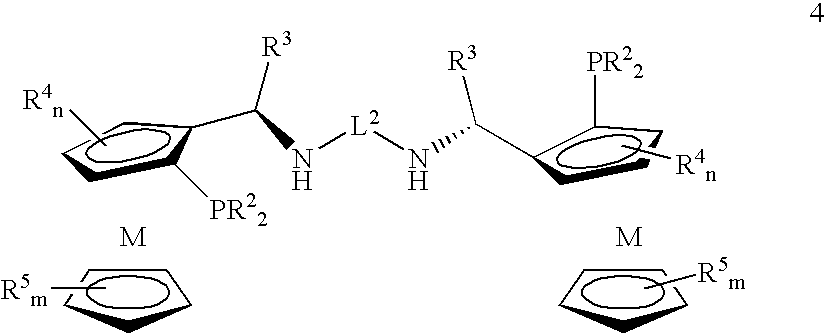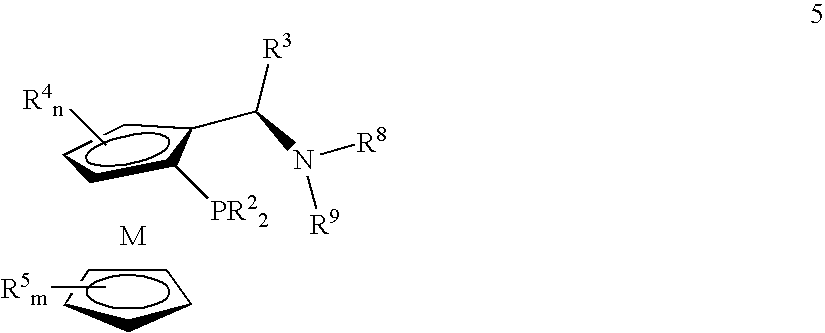Tetradentate ligands and metal complexes thereof for asymmetric catalysis
a technology which is applied in the field of tetradentate ligands and metal complexes thereof for asymmetric catalysis, can solve the problems of difficult to make, therefore expensive, and inability to meet the requirements of asymmetric catalysis, and achieve the effect of avoiding the formation of mixed complexes containing two bis-phosphines or two bis-amines around the metal
- Summary
- Abstract
- Description
- Claims
- Application Information
AI Technical Summary
Problems solved by technology
Method used
Image
Examples
example 1
Preparation of (S)-1-[(R)-2-(Diphenylphosphino)ferrocenyl]ethyl acetate (S,R-10a)
[0059] (S)-N,N-Dimethyl-1-[(R)-2-(diphenylphosphino)ferrocenyl]ethylamine (S,R-9a, R3═R8═R9=methyl, R2=phenyl-Ph, R4═R5═H, M=Fe))(5.0 g; 11.3 mmol) was combined with acetic anhydride (5.0 mL; 53 mmol; 4.7 equivalents). The flask was evacuated and filled with nitrogen ten times and then heated to 90° C. for 4 hours, at which point thin layer chromatography (tlc) analysis indicated no 9a present. The residual acetic anhydride was evaporated at reduced pressure, dissolved in ethyl acetate and concentrated two times to afford a crude solid. The crude product was dissolved in ethyl acetate (4 mL), diluted with heptane (20 mL) and cooled to 4° C. The resulting crystals were filtered, washed with heptane, and dried under nitrogen to afford 4.21 g (82%) of S,R-10a.
[0060]1H NMR (CDCl3) δ 7.6-7.1 (m, 10 H); 6.22 (m,1H); 4.573 (br s, 1H); 4.36 (m, 1H); 4.049 (s, 5H); 3.804 (m, 1H); 1.632 (d, J=6.32 Hz, 3H); 1.17...
example 2
Preparation of N,N′-Bis[(S)-1-[(R)-2-Diphenylphosphino)ferrocenyl]ethyl ethylenediamine (S-8a)
[0062] Ester S,R-10a (1.0 g; 2.19 mmol; 2.1 equiv) was combined with 5 mL of isopropanol and 2 mL of water. Ethylenediamine (69 mL; 1.04 mmol) was added and the mixture was heated to 50° C. Toluene (1 mL) was added and the reaction was heated overnight at 50° C., at which time a small amount of 10a was still present according to tic analysis. Triethylamine (0.30 mL) was added and the mixture was heated at 50° C. for 4 h to completely consume 10a according to tic analysis. The volatiles were distilled at reduced pressure and the residue was partitioned between 1 N sodium hydroxide and ethyl acetate. The layers were separated and the aqueous layer was extracted with additional ethyl acetate. The combined organic solution was extracted with 10% aqueous citric acid (4×5 mL). The aqueous extracts were made basic with 2 N sodium hydroxide (20 mL) and extracted three times with ethyl acetate. The...
example 3
Preparation of N,N′-Bis[(S)-1-[(R)-2-Diphenylphosphino)ferrocenyl]ethyl (R,R)-1,2-cyclohexyldiamine (S,R-8b)
[0065] Ester S,R-10a (1.0 g; 2.19 mmol) was combined with R,R-1,2-diaminocyclohexane (1.25 g; 10.95 mmol; 5 equiv) in 5 mL of isopropanol, 2 mL of water, and 1 mL of toluene. The reaction mixture was heated overnight at 50° C. to completely consume 10a according to tlc analysis. The reaction mixture was diluted with ethyl acetate and 1 N sodium hydroxide (10 mL). The layers were separated and the aqueous layer was extracted twice with ethyl acetate. The combined organic solution was dried (magnesium sulfate) and concentrated to afford 1.36 g of crude product. This material was filtered through a pad of flash silica gel and eluted with ethyl acetate to remove impurities, and then with 1:1 ethyl acetate:isopropanol with 5% added triethylamine to afford 0.92 g (82%) of S,R-11b.
[0066] A portion of this phosphinodiamine (0.71 g; 1.39 mmol) was combined with ester S,R-10a (952 mg;...
PUM
 Login to View More
Login to View More Abstract
Description
Claims
Application Information
 Login to View More
Login to View More - R&D
- Intellectual Property
- Life Sciences
- Materials
- Tech Scout
- Unparalleled Data Quality
- Higher Quality Content
- 60% Fewer Hallucinations
Browse by: Latest US Patents, China's latest patents, Technical Efficacy Thesaurus, Application Domain, Technology Topic, Popular Technical Reports.
© 2025 PatSnap. All rights reserved.Legal|Privacy policy|Modern Slavery Act Transparency Statement|Sitemap|About US| Contact US: help@patsnap.com



